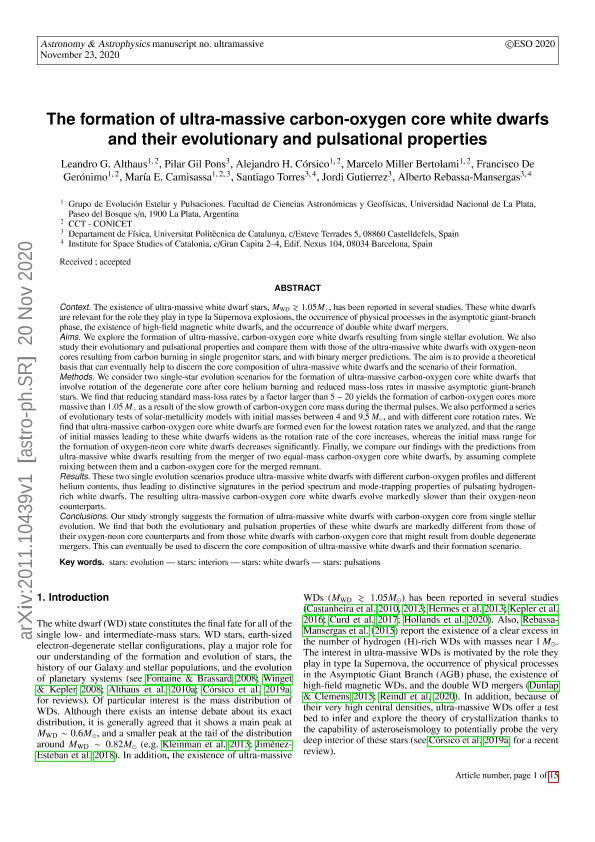Artículo
The formation of ultra-massive carbon-oxygen core white dwarfs and their evolutionary and pulsational properties
Althaus, Leandro Gabriel ; Pons, Pilar Gi; Corsico, Alejandro Hugo
; Pons, Pilar Gi; Corsico, Alejandro Hugo ; Miller Bertolami, Marcelo Miguel
; Miller Bertolami, Marcelo Miguel ; de Gerónimo, Francisco César
; de Gerónimo, Francisco César ; Camisassa, María Eugenia
; Camisassa, María Eugenia ; Torres, Santiago; Gutierrez, Jordi; Rebassa Mansergas, Alberto
; Torres, Santiago; Gutierrez, Jordi; Rebassa Mansergas, Alberto
 ; Pons, Pilar Gi; Corsico, Alejandro Hugo
; Pons, Pilar Gi; Corsico, Alejandro Hugo ; Miller Bertolami, Marcelo Miguel
; Miller Bertolami, Marcelo Miguel ; de Gerónimo, Francisco César
; de Gerónimo, Francisco César ; Camisassa, María Eugenia
; Camisassa, María Eugenia ; Torres, Santiago; Gutierrez, Jordi; Rebassa Mansergas, Alberto
; Torres, Santiago; Gutierrez, Jordi; Rebassa Mansergas, Alberto
Fecha de publicación:
02/2021
Editorial:
EDP Sciences
Revista:
Astronomy and Astrophysics
ISSN:
0004-6361
e-ISSN:
1432-0746
Idioma:
Inglés
Tipo de recurso:
Artículo publicado
Clasificación temática:
Resumen
Context. The existence of ultra-massive white dwarf stars, MWD & 1.05 M, has been reported in several studies. These white dwarfs are relevant for the role they play in type Ia supernova explosions, the occurrence of physical processes in the asymptotic giant-branch phase, the existence of high-field magnetic white dwarfs, and the occurrence of double-white-dwarf mergers. Aims. We aim to explore the formation of ultra-massive, carbon-oxygen core white dwarfs resulting from single stellar evolution. We also intend to study their evolutionary and pulsational properties and compare them with those of the ultra-massive white dwarfs with oxygen-neon cores resulting from carbon burning in single progenitor stars, and with binary merger predictions. The aim is to provide a theoretical basis that can eventually help to discern the core composition of ultra-massive white dwarfs and the circumstances of their formation. Methods. We considered two single-star evolution scenarios for the formation of ultra-massive carbon-oxygen core white dwarfs, which involve the rotation of the degenerate core after core helium burning and reduced mass-loss rates in massive asymptotic giant-branch stars. We find that reducing standard mass-loss rates by a factor larger than 5−20 yields the formation of carbon-oxygen cores more massive than 1.05 M as a result of the slow growth of carbon-oxygen core mass during the thermal pulses. We also performed a series of evolutionary tests of solar-metallicity models with initial masses between 4 and 9.5 M and with different core rotation rates. We find that ultra-massive carbon-oxygen core white dwarfs are formed even for the lowest rotation rates we analyzed, and that the range of initial masses leading to these white dwarfs widens as the rotation rate of the core increases, whereas the initial mass range for the formation of oxygen-neon core white dwarfs decreases significantly. Finally, we compared our findings with the predictions from ultra-massive white dwarfs resulting from the merger of two equal-mass carbon-oxygen core white dwarfs, by assuming complete mixing between them and a carbon-oxygen core for the merged remnant. Results. These two single-evolution scenarios produce ultra-massive white dwarfs with different carbon-oxygen profiles and different helium contents, thus leading to distinctive signatures in the period spectrum and mode-trapping properties of pulsating hydrogen-rich white dwarfs. The resulting ultra-massive carbon-oxygen core white dwarfs evolve markedly slower than their oxygen-neon counterparts. Conclusions. Our study strongly suggests the formation of ultra-massive white dwarfs with carbon-oxygen cores from a single stellar evolution. We find that both the evolutionary and pulsation properties of these white dwarfs are markedly different from those of their oxygen-neon core counterparts and from those white dwarfs with carbon-oxygen cores that might result from double-degenerate mergers. This can eventually be used to discern the core composition of ultra-massive white dwarfs and their formation scenario.
Palabras clave:
STARS: EVOLUTION
,
STARS: INTERIORS
,
STARS: OSCILLATIONS
,
WHITE DWARFS
Archivos asociados
Licencia
Identificadores
Colecciones
Articulos(IALP)
Articulos de INST.DE ASTROFISICA LA PLATA
Articulos de INST.DE ASTROFISICA LA PLATA
Citación
Althaus, Leandro Gabriel; Pons, Pilar Gi; Corsico, Alejandro Hugo; Miller Bertolami, Marcelo Miguel; de Gerónimo, Francisco César; et al.; The formation of ultra-massive carbon-oxygen core white dwarfs and their evolutionary and pulsational properties; EDP Sciences; Astronomy and Astrophysics; 646; 2-2021; 1-15
Compartir
Altmétricas



